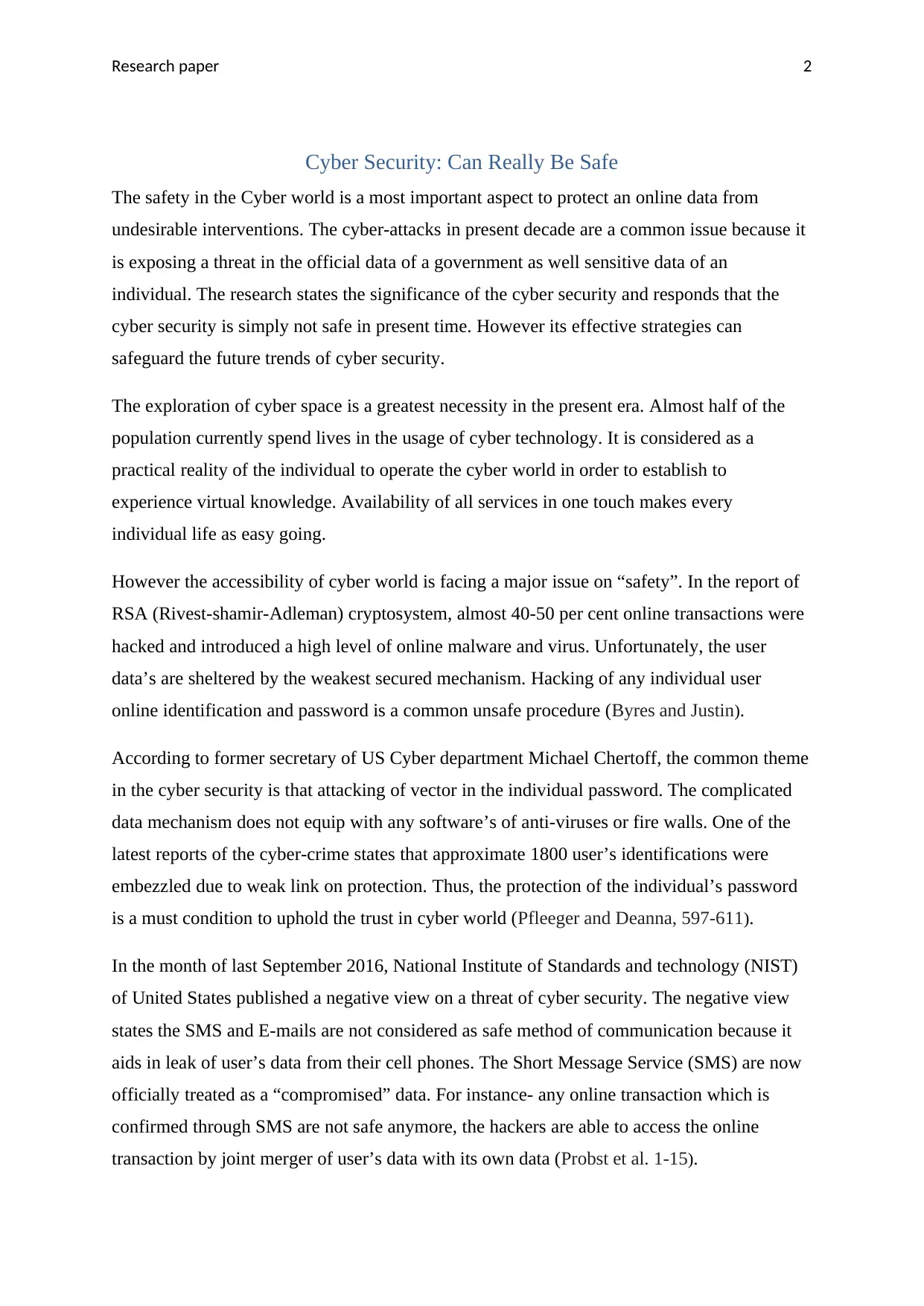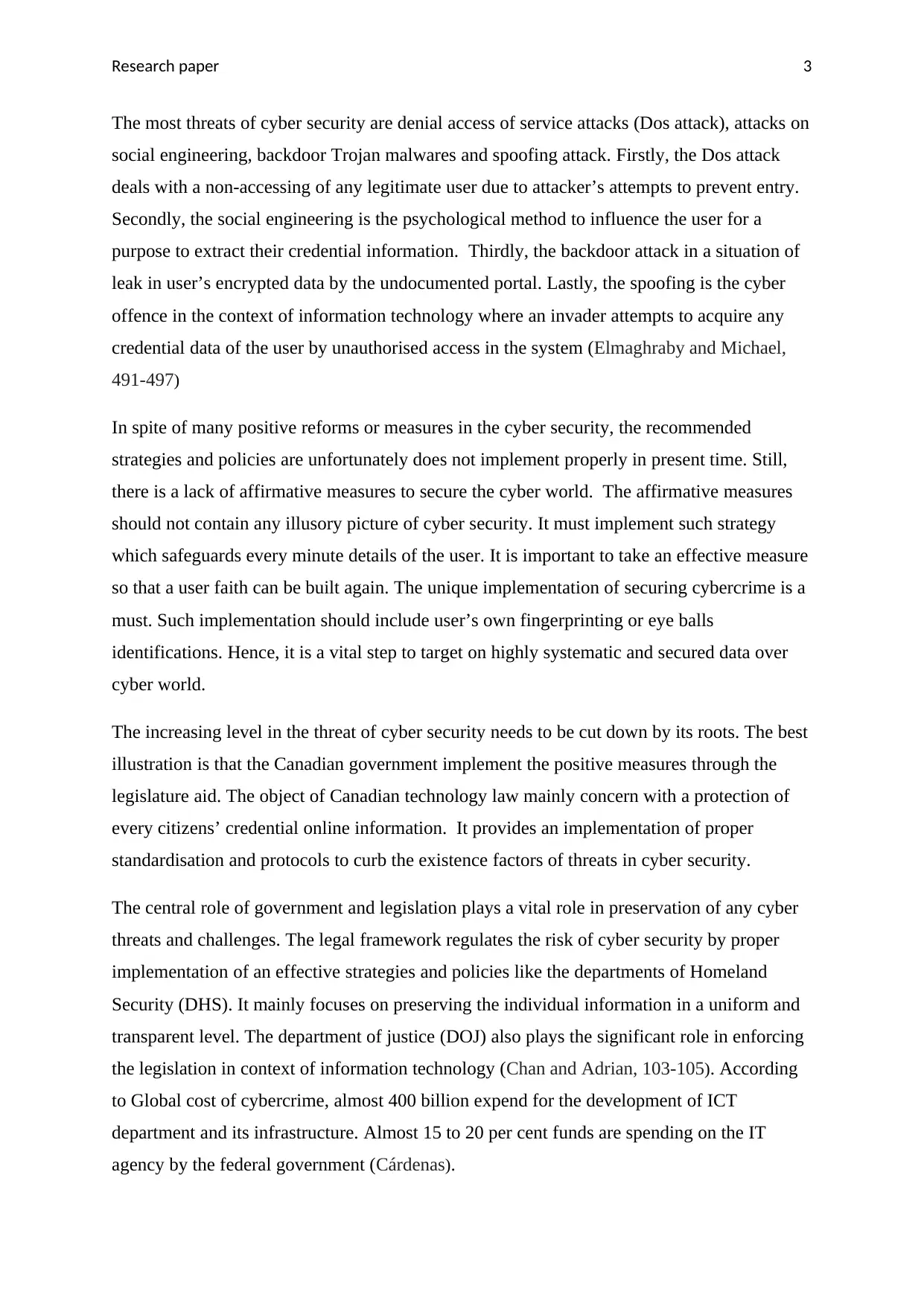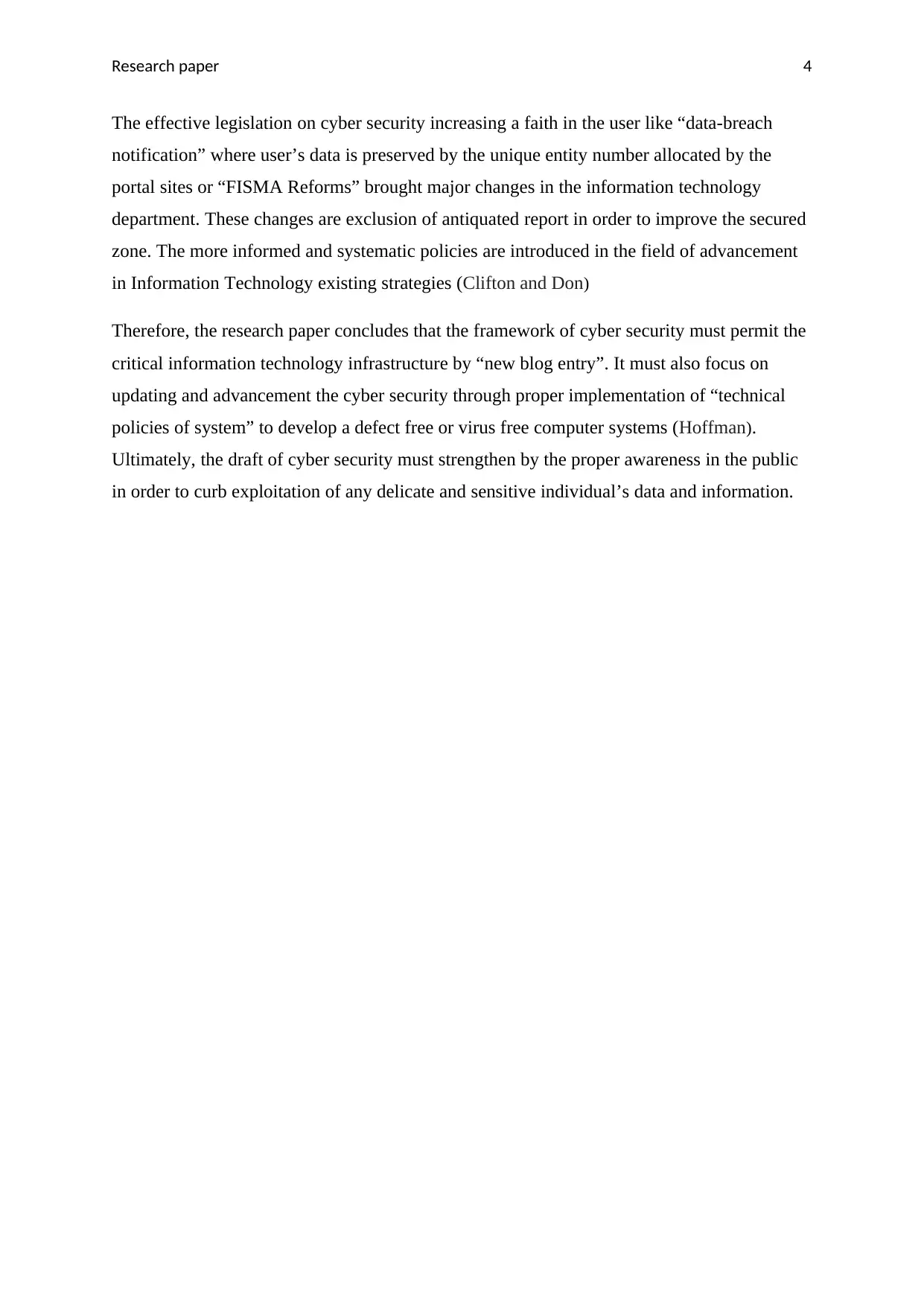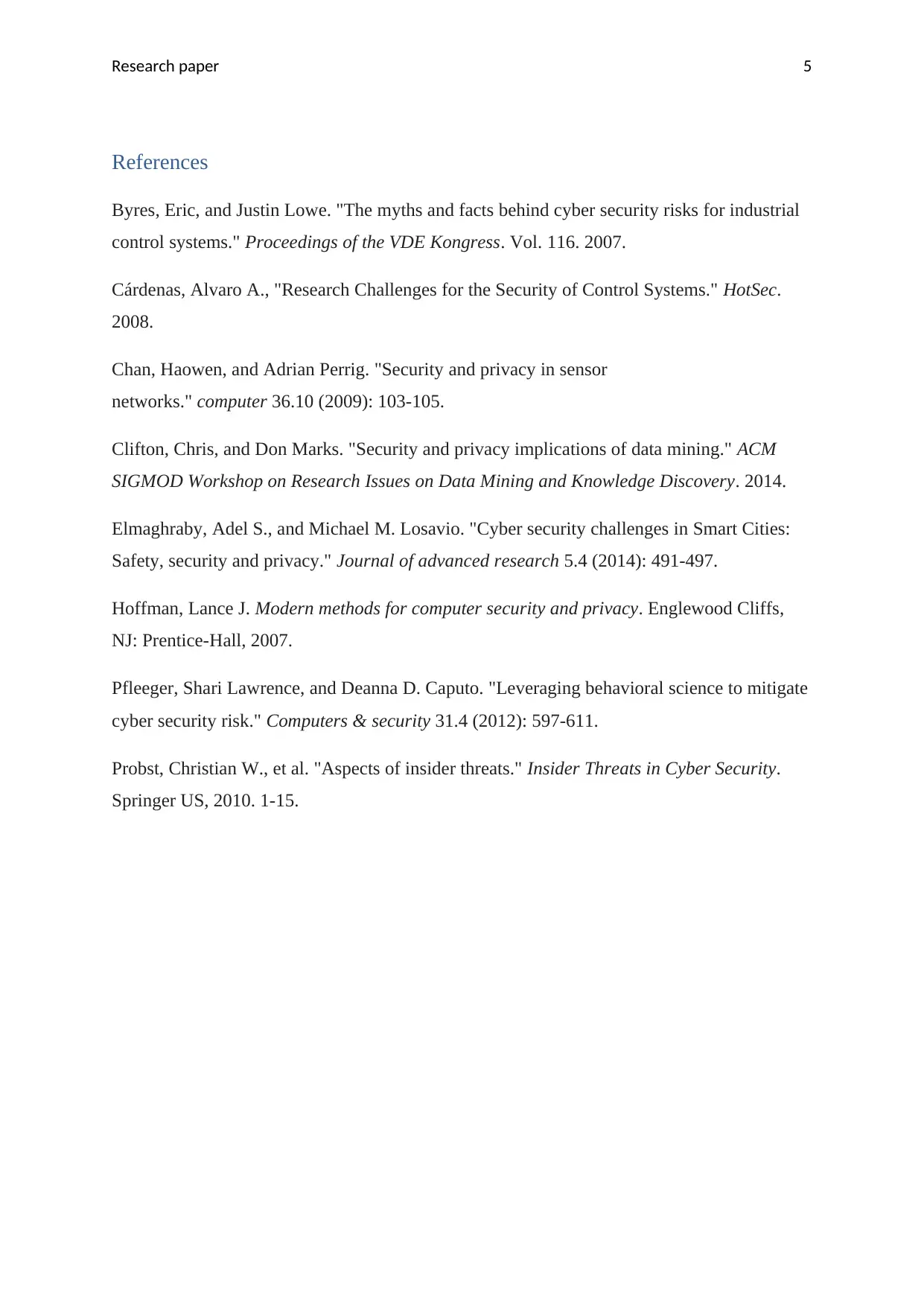Cyber Security: Evaluating Online Safety, Threats & Mitigation
VerifiedAdded on 2023/06/15
|6
|1384
|356
Report
AI Summary
This report explores the safety of cyberspace, highlighting the increasing threats to online data and individual privacy. It discusses the vulnerabilities in current security measures, such as weak password protection and compromised SMS communications. Various cyber-attack methods, including denial-of-service attacks, social engineering, and malware, are examined. The report emphasizes the need for stronger, more systematic security implementations, such as biometric identification, and draws attention to the role of government and legislation in protecting citizens' online information, citing examples like Canadian technology law and U.S. Department of Homeland Security initiatives. It concludes by advocating for continuous updates to cyber security infrastructure, improved technical policies, and increased public awareness to safeguard sensitive data, inviting readers to explore Desklib for related resources.

Running head: Research paper
Cyber Security
Cyber Security
Paraphrase This Document
Need a fresh take? Get an instant paraphrase of this document with our AI Paraphraser

Research paper 1
Contents
Cyber Security: Can Really Be Safe......................................................................................................1
References.............................................................................................................................................4
Contents
Cyber Security: Can Really Be Safe......................................................................................................1
References.............................................................................................................................................4

Research paper 2
Cyber Security: Can Really Be Safe
The safety in the Cyber world is a most important aspect to protect an online data from
undesirable interventions. The cyber-attacks in present decade are a common issue because it
is exposing a threat in the official data of a government as well sensitive data of an
individual. The research states the significance of the cyber security and responds that the
cyber security is simply not safe in present time. However its effective strategies can
safeguard the future trends of cyber security.
The exploration of cyber space is a greatest necessity in the present era. Almost half of the
population currently spend lives in the usage of cyber technology. It is considered as a
practical reality of the individual to operate the cyber world in order to establish to
experience virtual knowledge. Availability of all services in one touch makes every
individual life as easy going.
However the accessibility of cyber world is facing a major issue on “safety”. In the report of
RSA (Rivest-shamir-Adleman) cryptosystem, almost 40-50 per cent online transactions were
hacked and introduced a high level of online malware and virus. Unfortunately, the user
data’s are sheltered by the weakest secured mechanism. Hacking of any individual user
online identification and password is a common unsafe procedure (Byres and Justin).
According to former secretary of US Cyber department Michael Chertoff, the common theme
in the cyber security is that attacking of vector in the individual password. The complicated
data mechanism does not equip with any software’s of anti-viruses or fire walls. One of the
latest reports of the cyber-crime states that approximate 1800 user’s identifications were
embezzled due to weak link on protection. Thus, the protection of the individual’s password
is a must condition to uphold the trust in cyber world (Pfleeger and Deanna, 597-611).
In the month of last September 2016, National Institute of Standards and technology (NIST)
of United States published a negative view on a threat of cyber security. The negative view
states the SMS and E-mails are not considered as safe method of communication because it
aids in leak of user’s data from their cell phones. The Short Message Service (SMS) are now
officially treated as a “compromised” data. For instance- any online transaction which is
confirmed through SMS are not safe anymore, the hackers are able to access the online
transaction by joint merger of user’s data with its own data (Probst et al. 1-15).
Cyber Security: Can Really Be Safe
The safety in the Cyber world is a most important aspect to protect an online data from
undesirable interventions. The cyber-attacks in present decade are a common issue because it
is exposing a threat in the official data of a government as well sensitive data of an
individual. The research states the significance of the cyber security and responds that the
cyber security is simply not safe in present time. However its effective strategies can
safeguard the future trends of cyber security.
The exploration of cyber space is a greatest necessity in the present era. Almost half of the
population currently spend lives in the usage of cyber technology. It is considered as a
practical reality of the individual to operate the cyber world in order to establish to
experience virtual knowledge. Availability of all services in one touch makes every
individual life as easy going.
However the accessibility of cyber world is facing a major issue on “safety”. In the report of
RSA (Rivest-shamir-Adleman) cryptosystem, almost 40-50 per cent online transactions were
hacked and introduced a high level of online malware and virus. Unfortunately, the user
data’s are sheltered by the weakest secured mechanism. Hacking of any individual user
online identification and password is a common unsafe procedure (Byres and Justin).
According to former secretary of US Cyber department Michael Chertoff, the common theme
in the cyber security is that attacking of vector in the individual password. The complicated
data mechanism does not equip with any software’s of anti-viruses or fire walls. One of the
latest reports of the cyber-crime states that approximate 1800 user’s identifications were
embezzled due to weak link on protection. Thus, the protection of the individual’s password
is a must condition to uphold the trust in cyber world (Pfleeger and Deanna, 597-611).
In the month of last September 2016, National Institute of Standards and technology (NIST)
of United States published a negative view on a threat of cyber security. The negative view
states the SMS and E-mails are not considered as safe method of communication because it
aids in leak of user’s data from their cell phones. The Short Message Service (SMS) are now
officially treated as a “compromised” data. For instance- any online transaction which is
confirmed through SMS are not safe anymore, the hackers are able to access the online
transaction by joint merger of user’s data with its own data (Probst et al. 1-15).
⊘ This is a preview!⊘
Do you want full access?
Subscribe today to unlock all pages.

Trusted by 1+ million students worldwide

Research paper 3
The most threats of cyber security are denial access of service attacks (Dos attack), attacks on
social engineering, backdoor Trojan malwares and spoofing attack. Firstly, the Dos attack
deals with a non-accessing of any legitimate user due to attacker’s attempts to prevent entry.
Secondly, the social engineering is the psychological method to influence the user for a
purpose to extract their credential information. Thirdly, the backdoor attack in a situation of
leak in user’s encrypted data by the undocumented portal. Lastly, the spoofing is the cyber
offence in the context of information technology where an invader attempts to acquire any
credential data of the user by unauthorised access in the system (Elmaghraby and Michael,
491-497)
In spite of many positive reforms or measures in the cyber security, the recommended
strategies and policies are unfortunately does not implement properly in present time. Still,
there is a lack of affirmative measures to secure the cyber world. The affirmative measures
should not contain any illusory picture of cyber security. It must implement such strategy
which safeguards every minute details of the user. It is important to take an effective measure
so that a user faith can be built again. The unique implementation of securing cybercrime is a
must. Such implementation should include user’s own fingerprinting or eye balls
identifications. Hence, it is a vital step to target on highly systematic and secured data over
cyber world.
The increasing level in the threat of cyber security needs to be cut down by its roots. The best
illustration is that the Canadian government implement the positive measures through the
legislature aid. The object of Canadian technology law mainly concern with a protection of
every citizens’ credential online information. It provides an implementation of proper
standardisation and protocols to curb the existence factors of threats in cyber security.
The central role of government and legislation plays a vital role in preservation of any cyber
threats and challenges. The legal framework regulates the risk of cyber security by proper
implementation of an effective strategies and policies like the departments of Homeland
Security (DHS). It mainly focuses on preserving the individual information in a uniform and
transparent level. The department of justice (DOJ) also plays the significant role in enforcing
the legislation in context of information technology (Chan and Adrian, 103-105). According
to Global cost of cybercrime, almost 400 billion expend for the development of ICT
department and its infrastructure. Almost 15 to 20 per cent funds are spending on the IT
agency by the federal government (Cárdenas).
The most threats of cyber security are denial access of service attacks (Dos attack), attacks on
social engineering, backdoor Trojan malwares and spoofing attack. Firstly, the Dos attack
deals with a non-accessing of any legitimate user due to attacker’s attempts to prevent entry.
Secondly, the social engineering is the psychological method to influence the user for a
purpose to extract their credential information. Thirdly, the backdoor attack in a situation of
leak in user’s encrypted data by the undocumented portal. Lastly, the spoofing is the cyber
offence in the context of information technology where an invader attempts to acquire any
credential data of the user by unauthorised access in the system (Elmaghraby and Michael,
491-497)
In spite of many positive reforms or measures in the cyber security, the recommended
strategies and policies are unfortunately does not implement properly in present time. Still,
there is a lack of affirmative measures to secure the cyber world. The affirmative measures
should not contain any illusory picture of cyber security. It must implement such strategy
which safeguards every minute details of the user. It is important to take an effective measure
so that a user faith can be built again. The unique implementation of securing cybercrime is a
must. Such implementation should include user’s own fingerprinting or eye balls
identifications. Hence, it is a vital step to target on highly systematic and secured data over
cyber world.
The increasing level in the threat of cyber security needs to be cut down by its roots. The best
illustration is that the Canadian government implement the positive measures through the
legislature aid. The object of Canadian technology law mainly concern with a protection of
every citizens’ credential online information. It provides an implementation of proper
standardisation and protocols to curb the existence factors of threats in cyber security.
The central role of government and legislation plays a vital role in preservation of any cyber
threats and challenges. The legal framework regulates the risk of cyber security by proper
implementation of an effective strategies and policies like the departments of Homeland
Security (DHS). It mainly focuses on preserving the individual information in a uniform and
transparent level. The department of justice (DOJ) also plays the significant role in enforcing
the legislation in context of information technology (Chan and Adrian, 103-105). According
to Global cost of cybercrime, almost 400 billion expend for the development of ICT
department and its infrastructure. Almost 15 to 20 per cent funds are spending on the IT
agency by the federal government (Cárdenas).
Paraphrase This Document
Need a fresh take? Get an instant paraphrase of this document with our AI Paraphraser

Research paper 4
The effective legislation on cyber security increasing a faith in the user like “data-breach
notification” where user’s data is preserved by the unique entity number allocated by the
portal sites or “FISMA Reforms” brought major changes in the information technology
department. These changes are exclusion of antiquated report in order to improve the secured
zone. The more informed and systematic policies are introduced in the field of advancement
in Information Technology existing strategies (Clifton and Don)
Therefore, the research paper concludes that the framework of cyber security must permit the
critical information technology infrastructure by “new blog entry”. It must also focus on
updating and advancement the cyber security through proper implementation of “technical
policies of system” to develop a defect free or virus free computer systems (Hoffman).
Ultimately, the draft of cyber security must strengthen by the proper awareness in the public
in order to curb exploitation of any delicate and sensitive individual’s data and information.
The effective legislation on cyber security increasing a faith in the user like “data-breach
notification” where user’s data is preserved by the unique entity number allocated by the
portal sites or “FISMA Reforms” brought major changes in the information technology
department. These changes are exclusion of antiquated report in order to improve the secured
zone. The more informed and systematic policies are introduced in the field of advancement
in Information Technology existing strategies (Clifton and Don)
Therefore, the research paper concludes that the framework of cyber security must permit the
critical information technology infrastructure by “new blog entry”. It must also focus on
updating and advancement the cyber security through proper implementation of “technical
policies of system” to develop a defect free or virus free computer systems (Hoffman).
Ultimately, the draft of cyber security must strengthen by the proper awareness in the public
in order to curb exploitation of any delicate and sensitive individual’s data and information.

Research paper 5
References
Byres, Eric, and Justin Lowe. "The myths and facts behind cyber security risks for industrial
control systems." Proceedings of the VDE Kongress. Vol. 116. 2007.
Cárdenas, Alvaro A., "Research Challenges for the Security of Control Systems." HotSec.
2008.
Chan, Haowen, and Adrian Perrig. "Security and privacy in sensor
networks." computer 36.10 (2009): 103-105.
Clifton, Chris, and Don Marks. "Security and privacy implications of data mining." ACM
SIGMOD Workshop on Research Issues on Data Mining and Knowledge Discovery. 2014.
Elmaghraby, Adel S., and Michael M. Losavio. "Cyber security challenges in Smart Cities:
Safety, security and privacy." Journal of advanced research 5.4 (2014): 491-497.
Hoffman, Lance J. Modern methods for computer security and privacy. Englewood Cliffs,
NJ: Prentice-Hall, 2007.
Pfleeger, Shari Lawrence, and Deanna D. Caputo. "Leveraging behavioral science to mitigate
cyber security risk." Computers & security 31.4 (2012): 597-611.
Probst, Christian W., et al. "Aspects of insider threats." Insider Threats in Cyber Security.
Springer US, 2010. 1-15.
References
Byres, Eric, and Justin Lowe. "The myths and facts behind cyber security risks for industrial
control systems." Proceedings of the VDE Kongress. Vol. 116. 2007.
Cárdenas, Alvaro A., "Research Challenges for the Security of Control Systems." HotSec.
2008.
Chan, Haowen, and Adrian Perrig. "Security and privacy in sensor
networks." computer 36.10 (2009): 103-105.
Clifton, Chris, and Don Marks. "Security and privacy implications of data mining." ACM
SIGMOD Workshop on Research Issues on Data Mining and Knowledge Discovery. 2014.
Elmaghraby, Adel S., and Michael M. Losavio. "Cyber security challenges in Smart Cities:
Safety, security and privacy." Journal of advanced research 5.4 (2014): 491-497.
Hoffman, Lance J. Modern methods for computer security and privacy. Englewood Cliffs,
NJ: Prentice-Hall, 2007.
Pfleeger, Shari Lawrence, and Deanna D. Caputo. "Leveraging behavioral science to mitigate
cyber security risk." Computers & security 31.4 (2012): 597-611.
Probst, Christian W., et al. "Aspects of insider threats." Insider Threats in Cyber Security.
Springer US, 2010. 1-15.
⊘ This is a preview!⊘
Do you want full access?
Subscribe today to unlock all pages.

Trusted by 1+ million students worldwide
1 out of 6
Related Documents
Your All-in-One AI-Powered Toolkit for Academic Success.
+13062052269
info@desklib.com
Available 24*7 on WhatsApp / Email
![[object Object]](/_next/static/media/star-bottom.7253800d.svg)
Unlock your academic potential
Copyright © 2020–2025 A2Z Services. All Rights Reserved. Developed and managed by ZUCOL.





